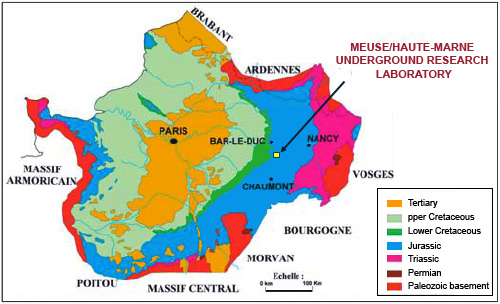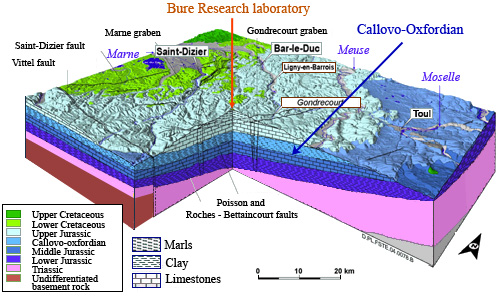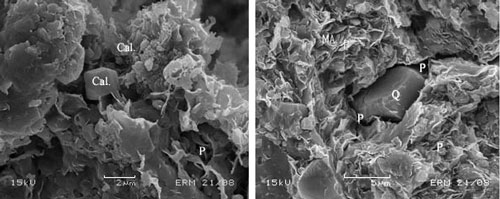The Callovo-Oxfordian argilite

The Paris Basin: a stable geological environment
The Paris Basin offers long-term geological stability on a very large scale, due in part to its low seismic risk. The argillaceous stratum is very uniform because of regular sedimentary deposits over time which were barely disturbed by tectonic movements. The depth of the layer (500 m) would protect future waste disposal facilities from erosion, climate change and, because clay has little market value, human intrusion.
© ANDRA
The geological stratum or ‘host rock’ that will accommodate the radioactive waste, is the final barrier, acting as a last resort when the lines of defense represented by the conditioning, containers and engineered barrier have given way. Its role, on timescales of thousands of years, will be to further slow down the migration of the final phalanx of radio elements that remain radioactive.
To host the future waste disposal facility France has chosen a deep layer of clay in the Paris Basin, formed approximately 155 million years ago and referred to as Callovo-Oxfordian. The proposed site of the waste disposal facility is on the boundary of the Meuse and Haute-Marne departments on the eastern edge of the Paris basin. The region is not rich in mineral resources like coal and oil that might cause mines to be dug there.
The qualities of argillite that make it suitable for the disposal of radioactive waste
From a geological point of view, the Paris basin is like a bowl filled with a succession of sedimentary layers, the oldest of which outcrop on the edges, and the most recent of which lie in the center of the basin in Ile de France. Because of their plasticity these layers contain no fractures, or very few.
Callovo-Oxfordian consists mainly of argillite, a very fine-grained sedimentary rock formed at the bottom of seas and lakes. It is a rock known for its very low permeability (water runs through it at a rate of a few centimeters every 10,000 years) and its superb ability to retain chemical elements. These two properties delay and limit the movement of the radioactive atoms in waste.

The Callovo-Oxfordian layer
France has focused its research on clay and has chosen a deep layer of clay, Callovo-Oxfordian, in the Paris basin to host its high-level and intermediate-level long-lived radioactive waste at some point in the future. A geological cutaway of the area around the future disposal facility site and the laboratory where the research is being carried out shows the Callovo-Oxfordian layer. At a depth of 500 m, between two limestone layers from the Jurassic period, the Callovo-Oxfordian layer is around 130 m thick, uniform and horizontal.
© ANDRA
At a disposal site the main enemy is water, which leaches materials. The argillite particles have spaces between them, pores where small quantities of water can be found, but the porosity (percentage of spaces) of argillite is low and the radius of the pores is less than one tenth of a micron. Consequently, water movement is absolutely minimal: argillite contains fossil water in its pores that has not moved since the rock was formed.
The chemical elements dissolved in it, whether they are radioactive or not, circulate mainly because of their own movement (by diffusion); they are not moved by currents of water because of the low permeability of the layer and because there are no significant differences in pressure. With diffusion, a slow movement mechanism, it would take thousands of years for them to be transferred to the environment.

The very low permeability of argillites
Argillite seen with an electron microscope. In the matrix you can see macropores (P), grains of quartz (Q) and calcite (Cal). The argillite particles leave 10 to 18% minuscule pores, spaces that can hold very small quantities of water, between them. The circulation of this water is extremely limited. Because the quartz, a highly resistant mineral, is a good conductor of heat, the rock is solid and is capable of removing the heat released by the radioactive waste. The chemical environment is stable due to the presence of 25% carbonates, which regulate the acidity of the rock.
© ANDRA
Molecules of water are trapped by microscopic crystals in the form of tiny clay mineral flakes. These flakes, which have electrically charged surfaces, retain certain elements such as the caesium and strontium in radioactive waste. The argillite also contains carbonates and quartzes, minerals that give it chemical stability, a certain amount of solidity and the ability to remove heat.
The stability of the chemical medium over time, no matter what disturbances occur due to the deterioration of the materials used for the disposal facility’s engineered structures, guarantees that the confinement properties of the clay are preserved. The mechanical properties of the rock prevent hairline cracks and fractures from forming as a result of the underground facility being dug, and increasing the permeability of the rock near the drifts.
These qualities, added to the excellent retention capacity, compactness and low permeability of the deep clay formations of the Callovo-Oxfordian, make these formations a particularly suitable medium for hosting high-level long-lived waste.
The flow of water through the geological layers above and below the Callovo-Oxfordian clay layer has also been studied. Water moves through these layers at the rate of a few meters per century at most.
Other articles on the subject « Geological disposal »
Waste duration
Nuclear spent fuel and vitrified waste: what legacy? “Much of this nuclear waste will remai[...]
CIGEO project
CIGEO – Overview of a planned repository The efforts made by engineers to ensure that highl[...]
Bure underground laboratory
A research laboratory for a disposal facility site Before high-level radioactive waste is buried [...]
Results on deep clay disposal
What we know about the disposal facility site In its final report in 2006 the French National Ass[...]
High-level waste repositories
Disposal of high-level waste packages The high-level waste packages requiring disposal will proba[...]
ILW-LL waste repositories
Filling an intermediate-level waste disposal cell Intermediate-level (ILW-LL) waste releases litt[...]
Waste disposal USA
Back to the drawing board after Yucca Mountain WIPP, the first deep geological repository to begi[...]
WIPP Project
The world’s first deep geological repository The United States is the first country in the [...]
Waste disposal Sweden
Sweden and Finland – Exemplary waste management Sweden probably features among the E[...]
Other countries
Shared challenges and similar solutions In most countries with nuclear industries, solutions for [...]